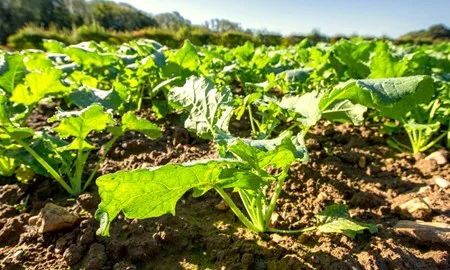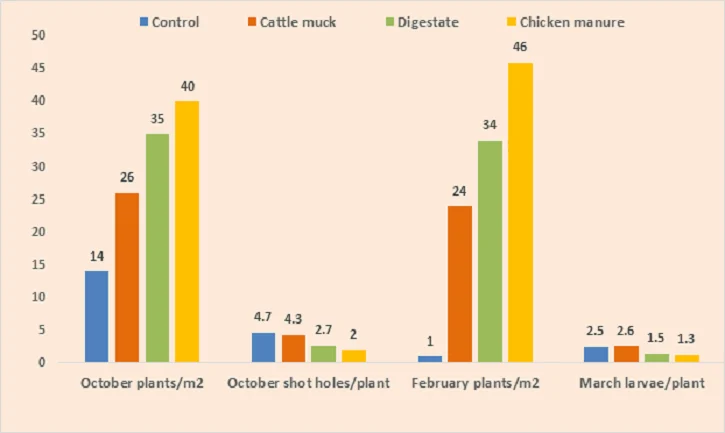
Author
| 28th May 2020How organic manuring can help reduce cabbage stem flea beetle damage
Organic manuring ahead of drilling can noticeably reduce damage from both cabbage stem flea beetle adults and larvae as well as improving crop establishment, according to the latest Royal Agricultural University study. But its value very much depends on the type of manure.
The current season study by undergraduate student, Ted Allen-Stevens with Dr Nicola Cannon shows well-rotted chicken manure delivering better results than either digestate or cattle muck across 1ha direct-drilled plots in an early September-sown Gloucestershire crop.
“The warm, dry weather in mid-September really impeded crop establishment and heightened flea beetle activity,” reports Mr Allen-Stevens. “Thankfully, a combination of two pyrethroid sprays and cooler, wetter conditions from the last week of the month turned the tables in the crop’s favour, allowing all but the control plot to establish satisfactorily.
“The extra pressure of the wet winter led the control plot to fail completely, while the manured plots came into the spring with average populations of between 24 and 48 plants/m2.
“Cattle muck was the least successful of our treatments,” he explains. “Even so, the 20t/ha we surface applied the day before drilling – supplying 8.5kg N/ha – led to higher average October and February plant counts than the control. Similar levels of shot-holing/plant in the autumn and larvae/plant in the late-spring suggests its value here was entirely nutritive.”
Unsurprisingly, given the higher levels of N supplied, 20m3/ha of digestate and 9t/ha of chicken manure both markedly improved autumn and spring plant populations. They also resulted in less shot-holing and fewer larvae/plant.
Very surprising, though, were the noticeably higher autumn and spring plant populations and lower levels of adult and larval damage with the chicken manure which supplied just13.1 kg N/ha compared to the digestate supplying 62.2kg N/ha.
“Despite containing only around a fifth of the nitrogen and in a less readily available form than the digestate, the chicken manure came out on top in every respect, with the possible exception of very early plant counts,” Mr Allen-Stevens points out.
“Both these treatments appear to have had a deterrent effect on adult beetle feeding – masking the isothiocyanate exudates from the crop known to attract them, perhaps; an effect that would naturally feed through to lower larval burdens.
“Chicken manure was the stand-out here. Like the digestate, it gave more even ground cover than the cattle muck. It also had a much stronger effluent effect (odour) on application.”
Figure 1: Fairford Organic Manuring Trial Findings 2019/20

Source: Ted Allen-Stevens; Royal Agricultural University 2020
Cabbage Stem Flea Beetle Solutions
Our resource identifies the most promising ways to Battle the Beetle and ensure OSR remains a key part of your combinable crop rotation.
Cabbage Stem Flea Beetle Solutions